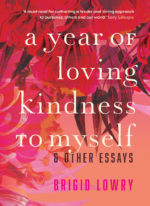Looking for creative writing tips to use in the classroom? Brigid Lowry’s new book might be the key to unlocking creativity

Chosen as Apple’s Book of the Month in April, one reviewer described Brigid’s book, A Year of Loving Kindness to Myself, and Other Essays, as ‘an exquisitely unembellished Zen lesson in the art of attention’. As Brigid explains below, cultivating that attention can be a key source of inspiration for students in creative writing.
Lists are a simple way to get creativity flowing. Students may be inspired by some from my book:
Lists
Lists are fun, and can be an easy way to start; they can also be authentic, meaningful, profound. And can easily lead creativity into a variety of directions. You could get students to start with some ideas from my book:
- Gratitude
- Things to do when life goes sideways
- A few of my dreams
- Things not written about
Or they can branch out with ideas like these:
- Best or strangest names for dogs, bands or websites
- Things to do while watching a sunset
- People not to invite to a dinner party
- Ten things I would change if I was in charge of the universe
- Describe a character with a list of what is in their bedroom, kitchen or shed.
Invent your own religion
After reading and discussing ‘On the spiritual life’, invent your own religion. Does it have a building as a place of worship? Describe it. Do followers wear special outfits? What are its guiding principles? What’s your religion’s name (see if you can do better than the Big Royal, or Gloria Zanzibar Magnolia)?
Write a piece titled ‘One happy moment’
After reading and discussing ‘On solace’, write about you have found that keeps you sane and happy. What have you tried – or seen others try – that you believe doesn’t lead to happiness?
Write from three points of view
After reading and discussing ‘On an ordinary day’, write about climate change in the voice of one of these characters: a seven-year-old child, a 20-year-old and an elderly person.
After reading and discussing ‘On friendship’, write a piece in two different voices, in which each character gives their version of why their friendship ended.
Write what you love
Based on ‘The singing heart kitchen’, choose an activity that you love, and write about why you love it.
The answers
Read and discuss ‘On questions.’ Have the class write their answers to the five questions that they find the most interesting.
Journaling
After reading and discussing ‘On journals, notebooks, diaries and me’, set the task of journaling for a week, or longer (so that privacy is maintained and to ensure they feel comfortable, each student will hold up their work and talk about their process – what they liked and did not like about doing this exercise, what they learned, etc. There is no obligation to share the content, unless they wish to.). Provide a very loose definition of journaling, so that students find a way of doing it that works for them: a visual diary, a small travelling notebook, an old-fashioned diary, a poem a day, etc.
Write a prayer
After reading and discussing ‘On New Year’s Eve, a prayer’, have students write their own prayer. Michael Leunig also has some great examples of wonderful prayers to inspire this exercise.
Other possibilities for creative writing classes
Get students to write their own writing topics or questions and put them into hat. Pass the hat so each student ends up with someone else’s idea, and have them write about it.
Write about the strangest thing you ever had to do. Once, as an icebreaker at an event, we had to smoosh up a Weet-bix and see who could write our names with the flakes the fastest.
Many more creative writing ideas for high school students can be found in Brigid’s book, Juicy Writing: Inspiration and Techniques for Young Writers. Allen & Unwin, 2008.



